Project Management on ‘Bucks Students’
VerifiedAdded on 2021/07/07
|12
|2531
|243
AI Summary
Contribute Materials
Your contribution can guide someone’s learning journey. Share your
documents today.
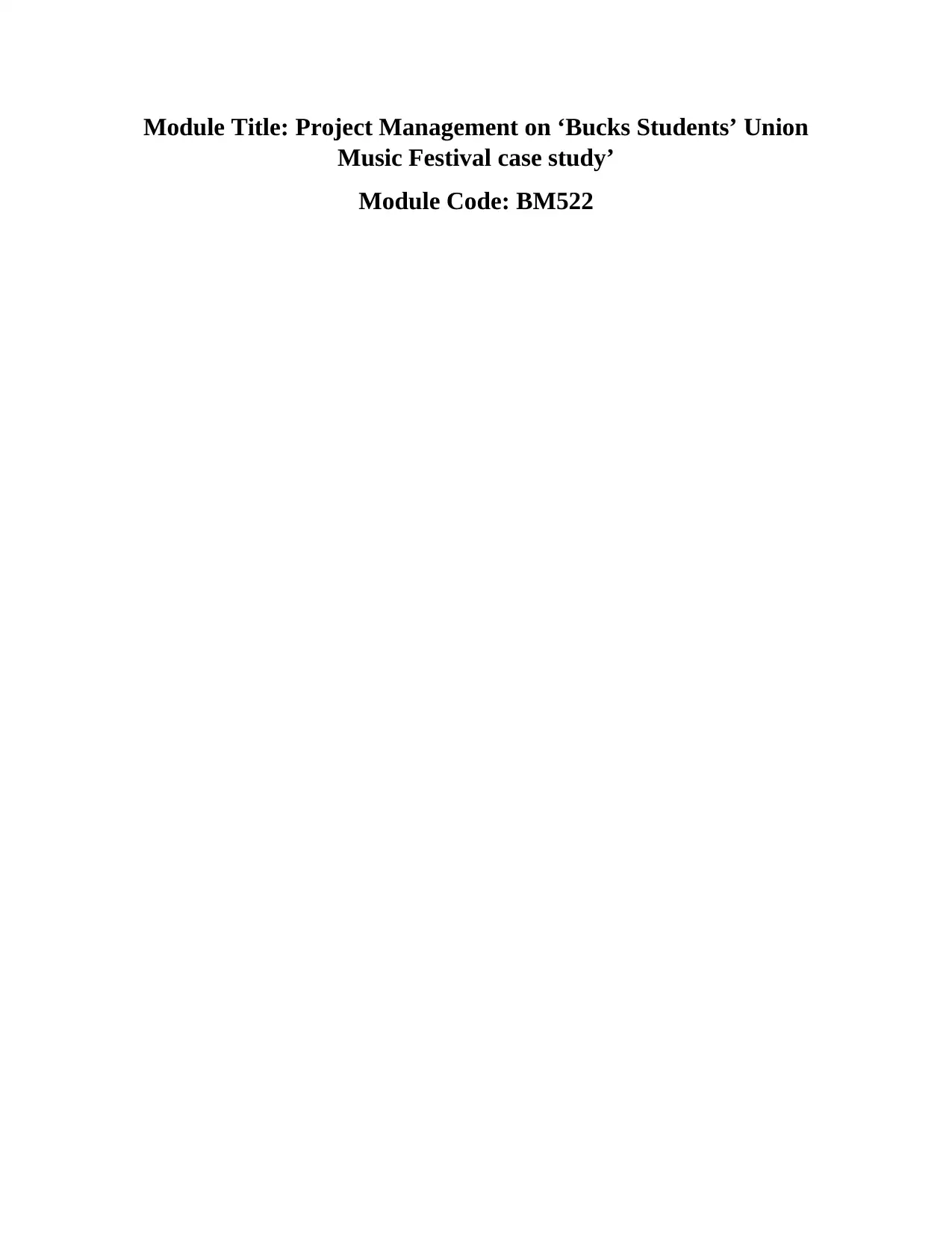
Module Title: Project Management on ‘Bucks Students’ Union
Music Festival case study’
Module Code: BM522
Music Festival case study’
Module Code: BM522
Secure Best Marks with AI Grader
Need help grading? Try our AI Grader for instant feedback on your assignments.
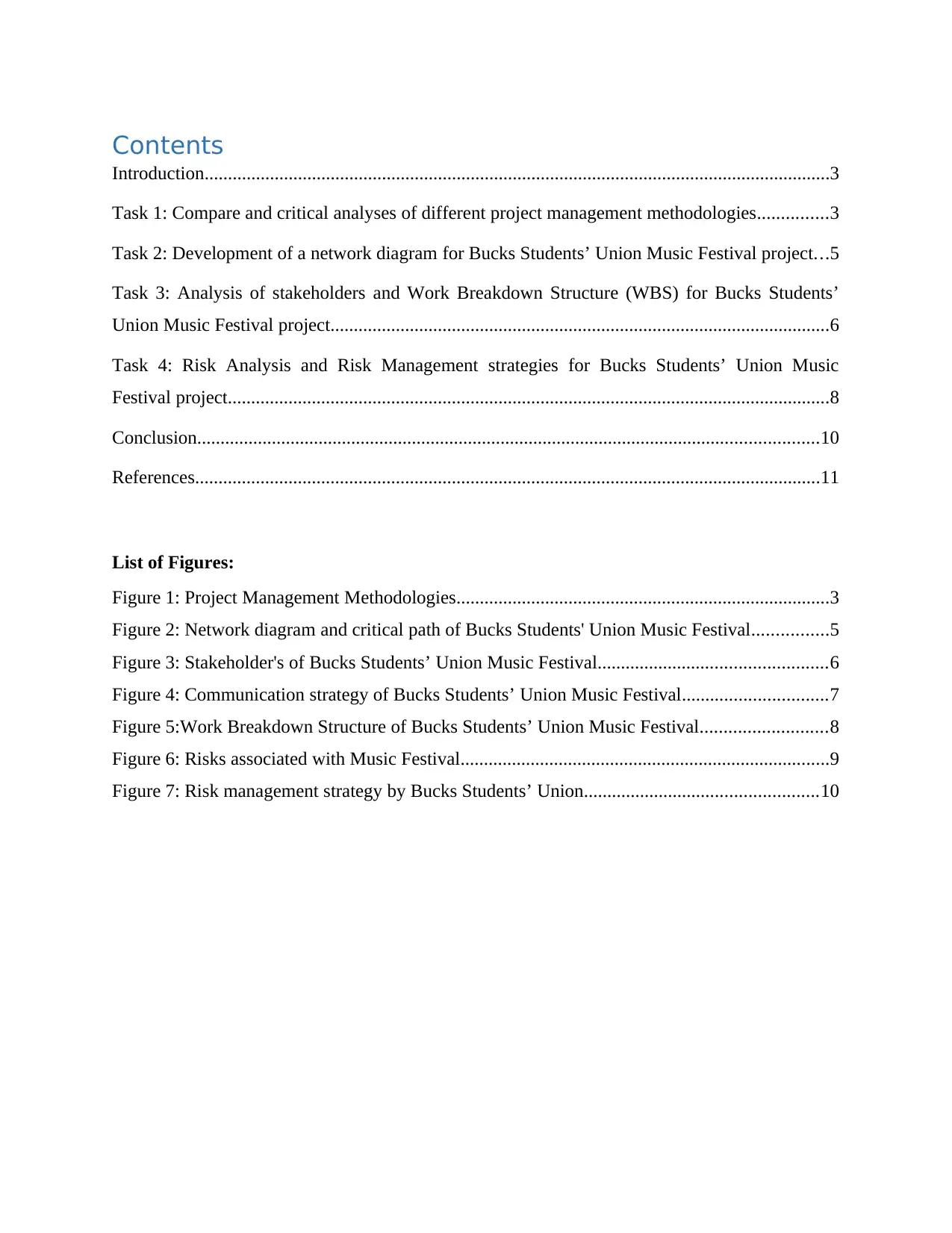
Contents
Introduction......................................................................................................................................3
Task 1: Compare and critical analyses of different project management methodologies...............3
Task 2: Development of a network diagram for Bucks Students’ Union Music Festival project...5
Task 3: Analysis of stakeholders and Work Breakdown Structure (WBS) for Bucks Students’
Union Music Festival project...........................................................................................................6
Task 4: Risk Analysis and Risk Management strategies for Bucks Students’ Union Music
Festival project.................................................................................................................................8
Conclusion.....................................................................................................................................10
References......................................................................................................................................11
List of Figures:
Figure 1: Project Management Methodologies................................................................................3
Figure 2: Network diagram and critical path of Bucks Students' Union Music Festival................5
Figure 3: Stakeholder's of Bucks Students’ Union Music Festival.................................................6
Figure 4: Communication strategy of Bucks Students’ Union Music Festival...............................7
Figure 5:Work Breakdown Structure of Bucks Students’ Union Music Festival...........................8
Figure 6: Risks associated with Music Festival...............................................................................9
Figure 7: Risk management strategy by Bucks Students’ Union..................................................10
Introduction......................................................................................................................................3
Task 1: Compare and critical analyses of different project management methodologies...............3
Task 2: Development of a network diagram for Bucks Students’ Union Music Festival project...5
Task 3: Analysis of stakeholders and Work Breakdown Structure (WBS) for Bucks Students’
Union Music Festival project...........................................................................................................6
Task 4: Risk Analysis and Risk Management strategies for Bucks Students’ Union Music
Festival project.................................................................................................................................8
Conclusion.....................................................................................................................................10
References......................................................................................................................................11
List of Figures:
Figure 1: Project Management Methodologies................................................................................3
Figure 2: Network diagram and critical path of Bucks Students' Union Music Festival................5
Figure 3: Stakeholder's of Bucks Students’ Union Music Festival.................................................6
Figure 4: Communication strategy of Bucks Students’ Union Music Festival...............................7
Figure 5:Work Breakdown Structure of Bucks Students’ Union Music Festival...........................8
Figure 6: Risks associated with Music Festival...............................................................................9
Figure 7: Risk management strategy by Bucks Students’ Union..................................................10
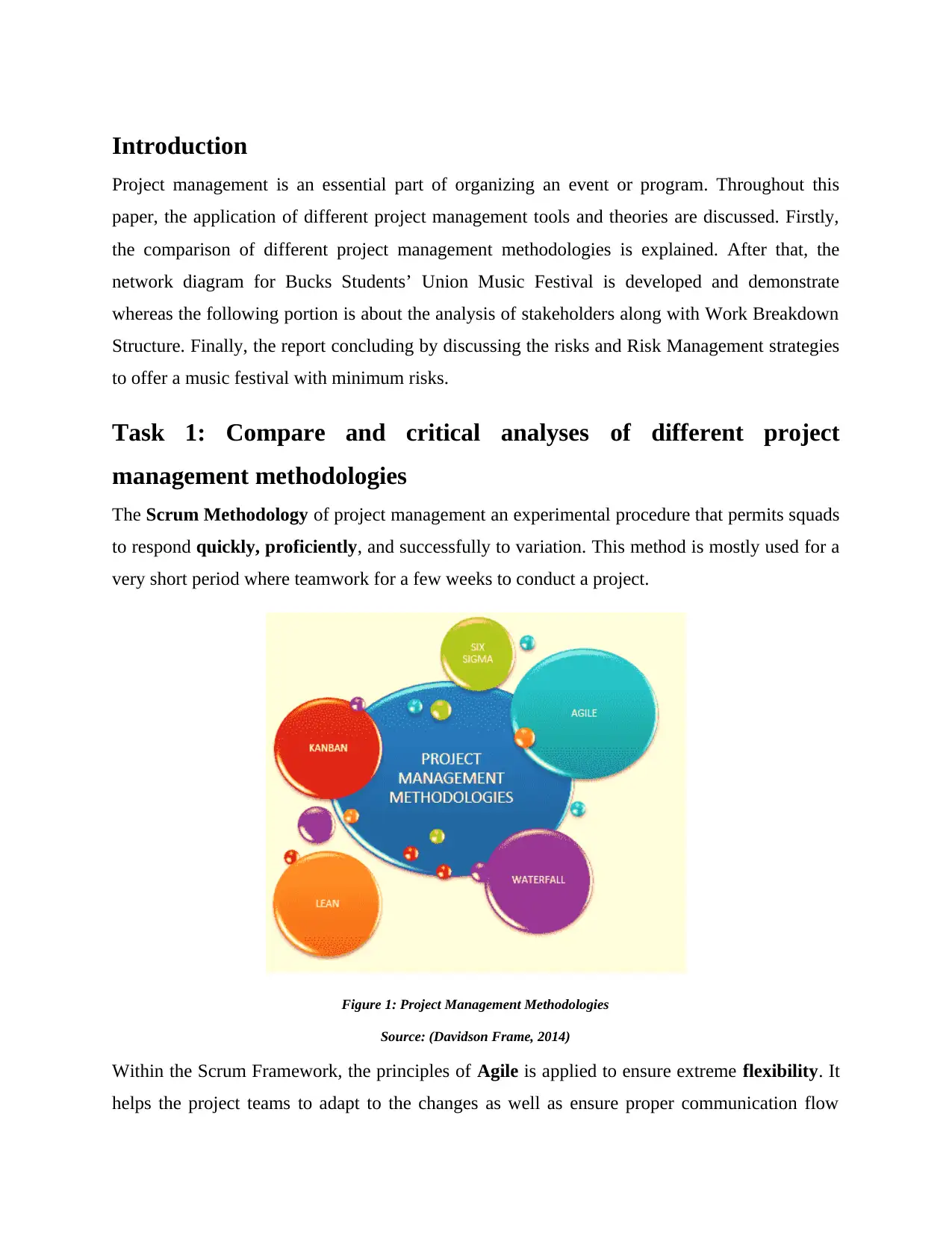
Introduction
Project management is an essential part of organizing an event or program. Throughout this
paper, the application of different project management tools and theories are discussed. Firstly,
the comparison of different project management methodologies is explained. After that, the
network diagram for Bucks Students’ Union Music Festival is developed and demonstrate
whereas the following portion is about the analysis of stakeholders along with Work Breakdown
Structure. Finally, the report concluding by discussing the risks and Risk Management strategies
to offer a music festival with minimum risks.
Task 1: Compare and critical analyses of different project
management methodologies
The Scrum Methodology of project management an experimental procedure that permits squads
to respond quickly, proficiently, and successfully to variation. This method is mostly used for a
very short period where teamwork for a few weeks to conduct a project.
Figure 1: Project Management Methodologies
Source: (Davidson Frame, 2014)
Within the Scrum Framework, the principles of Agile is applied to ensure extreme flexibility. It
helps the project teams to adapt to the changes as well as ensure proper communication flow
Project management is an essential part of organizing an event or program. Throughout this
paper, the application of different project management tools and theories are discussed. Firstly,
the comparison of different project management methodologies is explained. After that, the
network diagram for Bucks Students’ Union Music Festival is developed and demonstrate
whereas the following portion is about the analysis of stakeholders along with Work Breakdown
Structure. Finally, the report concluding by discussing the risks and Risk Management strategies
to offer a music festival with minimum risks.
Task 1: Compare and critical analyses of different project
management methodologies
The Scrum Methodology of project management an experimental procedure that permits squads
to respond quickly, proficiently, and successfully to variation. This method is mostly used for a
very short period where teamwork for a few weeks to conduct a project.
Figure 1: Project Management Methodologies
Source: (Davidson Frame, 2014)
Within the Scrum Framework, the principles of Agile is applied to ensure extreme flexibility. It
helps the project teams to adapt to the changes as well as ensure proper communication flow
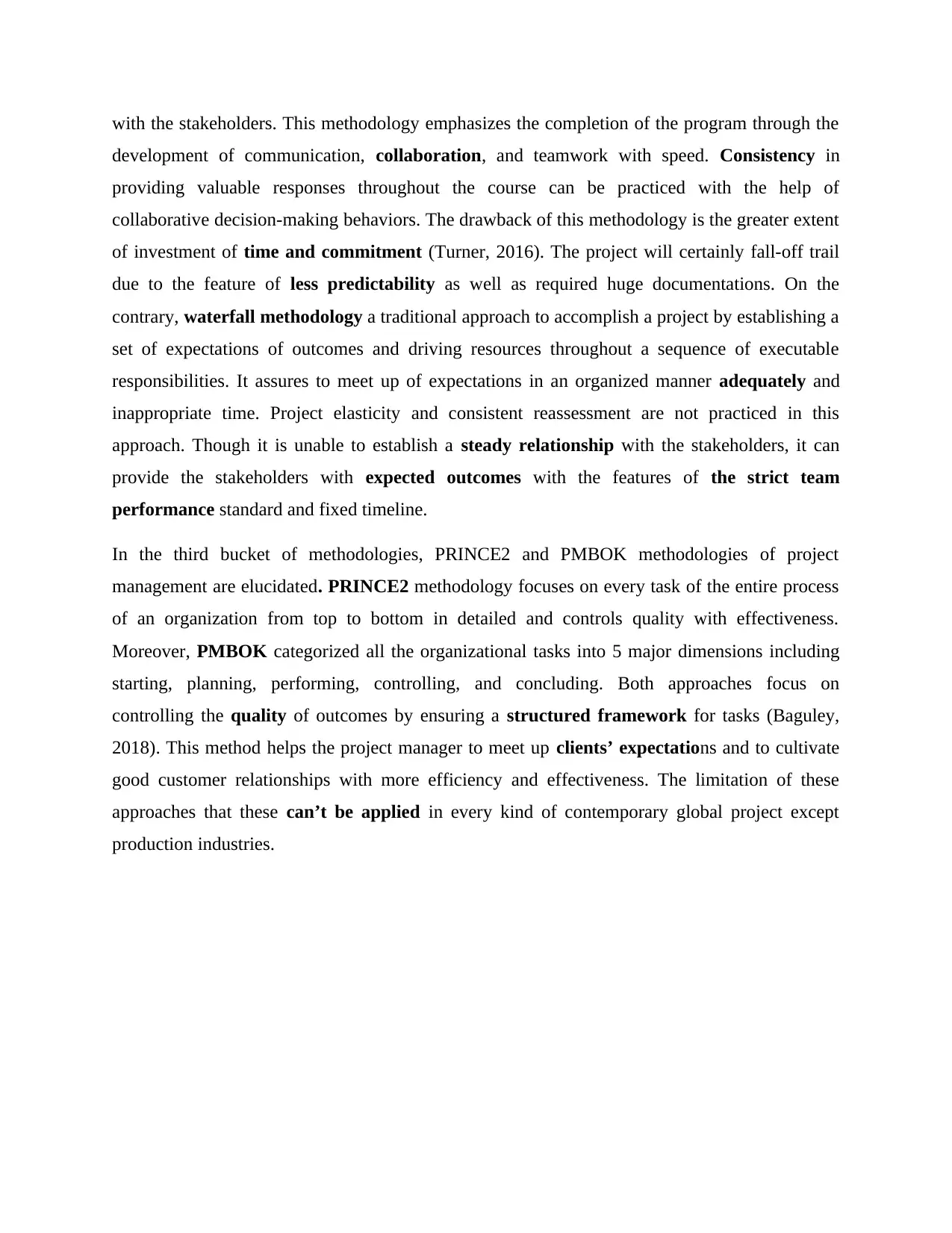
with the stakeholders. This methodology emphasizes the completion of the program through the
development of communication, collaboration, and teamwork with speed. Consistency in
providing valuable responses throughout the course can be practiced with the help of
collaborative decision-making behaviors. The drawback of this methodology is the greater extent
of investment of time and commitment (Turner, 2016). The project will certainly fall-off trail
due to the feature of less predictability as well as required huge documentations. On the
contrary, waterfall methodology a traditional approach to accomplish a project by establishing a
set of expectations of outcomes and driving resources throughout a sequence of executable
responsibilities. It assures to meet up of expectations in an organized manner adequately and
inappropriate time. Project elasticity and consistent reassessment are not practiced in this
approach. Though it is unable to establish a steady relationship with the stakeholders, it can
provide the stakeholders with expected outcomes with the features of the strict team
performance standard and fixed timeline.
In the third bucket of methodologies, PRINCE2 and PMBOK methodologies of project
management are elucidated. PRINCE2 methodology focuses on every task of the entire process
of an organization from top to bottom in detailed and controls quality with effectiveness.
Moreover, PMBOK categorized all the organizational tasks into 5 major dimensions including
starting, planning, performing, controlling, and concluding. Both approaches focus on
controlling the quality of outcomes by ensuring a structured framework for tasks (Baguley,
2018). This method helps the project manager to meet up clients’ expectations and to cultivate
good customer relationships with more efficiency and effectiveness. The limitation of these
approaches that these can’t be applied in every kind of contemporary global project except
production industries.
development of communication, collaboration, and teamwork with speed. Consistency in
providing valuable responses throughout the course can be practiced with the help of
collaborative decision-making behaviors. The drawback of this methodology is the greater extent
of investment of time and commitment (Turner, 2016). The project will certainly fall-off trail
due to the feature of less predictability as well as required huge documentations. On the
contrary, waterfall methodology a traditional approach to accomplish a project by establishing a
set of expectations of outcomes and driving resources throughout a sequence of executable
responsibilities. It assures to meet up of expectations in an organized manner adequately and
inappropriate time. Project elasticity and consistent reassessment are not practiced in this
approach. Though it is unable to establish a steady relationship with the stakeholders, it can
provide the stakeholders with expected outcomes with the features of the strict team
performance standard and fixed timeline.
In the third bucket of methodologies, PRINCE2 and PMBOK methodologies of project
management are elucidated. PRINCE2 methodology focuses on every task of the entire process
of an organization from top to bottom in detailed and controls quality with effectiveness.
Moreover, PMBOK categorized all the organizational tasks into 5 major dimensions including
starting, planning, performing, controlling, and concluding. Both approaches focus on
controlling the quality of outcomes by ensuring a structured framework for tasks (Baguley,
2018). This method helps the project manager to meet up clients’ expectations and to cultivate
good customer relationships with more efficiency and effectiveness. The limitation of these
approaches that these can’t be applied in every kind of contemporary global project except
production industries.
Secure Best Marks with AI Grader
Need help grading? Try our AI Grader for instant feedback on your assignments.
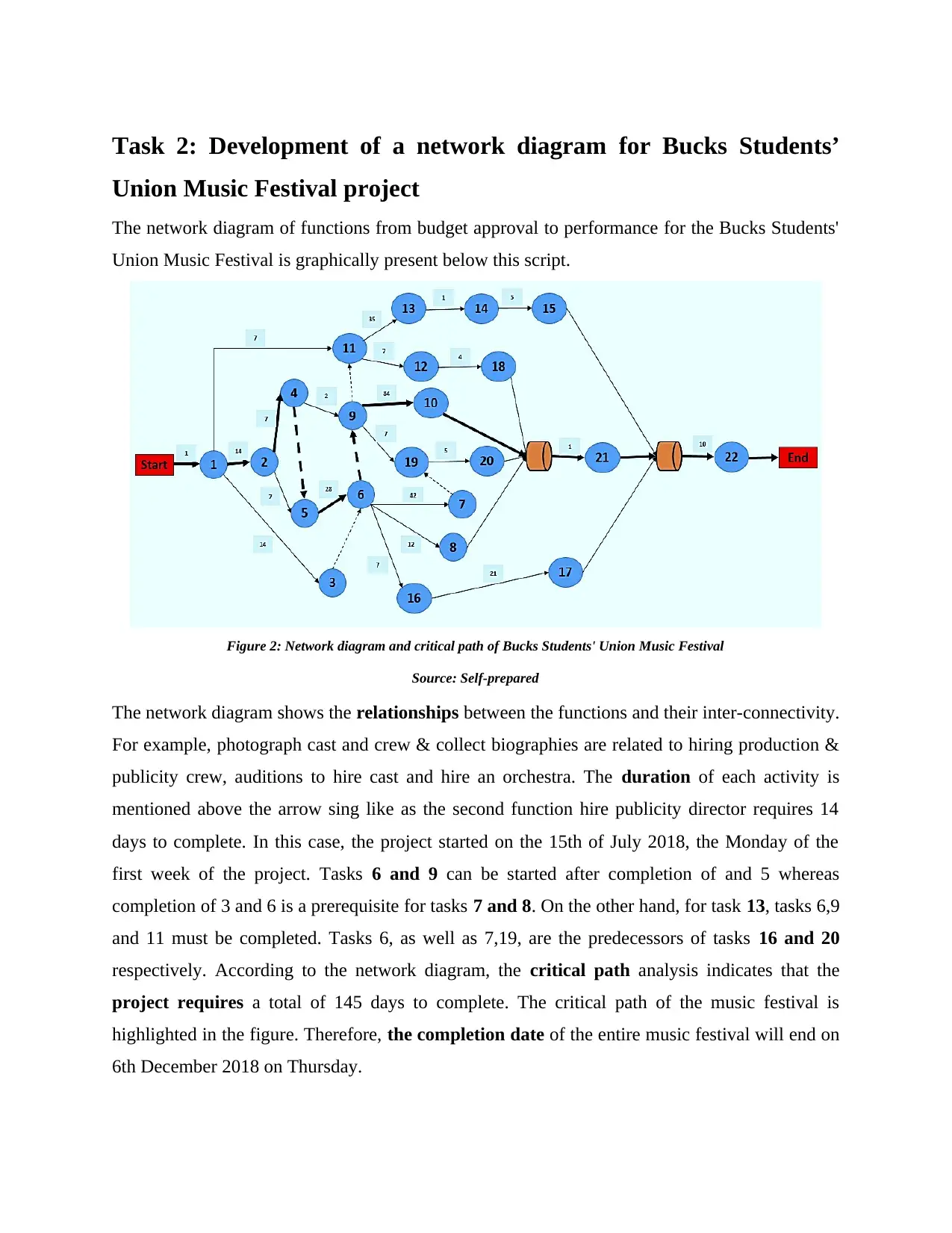
Task 2: Development of a network diagram for Bucks Students’
Union Music Festival project
The network diagram of functions from budget approval to performance for the Bucks Students'
Union Music Festival is graphically present below this script.
Figure 2: Network diagram and critical path of Bucks Students' Union Music Festival
Source: Self-prepared
The network diagram shows the relationships between the functions and their inter-connectivity.
For example, photograph cast and crew & collect biographies are related to hiring production &
publicity crew, auditions to hire cast and hire an orchestra. The duration of each activity is
mentioned above the arrow sing like as the second function hire publicity director requires 14
days to complete. In this case, the project started on the 15th of July 2018, the Monday of the
first week of the project. Tasks 6 and 9 can be started after completion of and 5 whereas
completion of 3 and 6 is a prerequisite for tasks 7 and 8. On the other hand, for task 13, tasks 6,9
and 11 must be completed. Tasks 6, as well as 7,19, are the predecessors of tasks 16 and 20
respectively. According to the network diagram, the critical path analysis indicates that the
project requires a total of 145 days to complete. The critical path of the music festival is
highlighted in the figure. Therefore, the completion date of the entire music festival will end on
6th December 2018 on Thursday.
Union Music Festival project
The network diagram of functions from budget approval to performance for the Bucks Students'
Union Music Festival is graphically present below this script.
Figure 2: Network diagram and critical path of Bucks Students' Union Music Festival
Source: Self-prepared
The network diagram shows the relationships between the functions and their inter-connectivity.
For example, photograph cast and crew & collect biographies are related to hiring production &
publicity crew, auditions to hire cast and hire an orchestra. The duration of each activity is
mentioned above the arrow sing like as the second function hire publicity director requires 14
days to complete. In this case, the project started on the 15th of July 2018, the Monday of the
first week of the project. Tasks 6 and 9 can be started after completion of and 5 whereas
completion of 3 and 6 is a prerequisite for tasks 7 and 8. On the other hand, for task 13, tasks 6,9
and 11 must be completed. Tasks 6, as well as 7,19, are the predecessors of tasks 16 and 20
respectively. According to the network diagram, the critical path analysis indicates that the
project requires a total of 145 days to complete. The critical path of the music festival is
highlighted in the figure. Therefore, the completion date of the entire music festival will end on
6th December 2018 on Thursday.
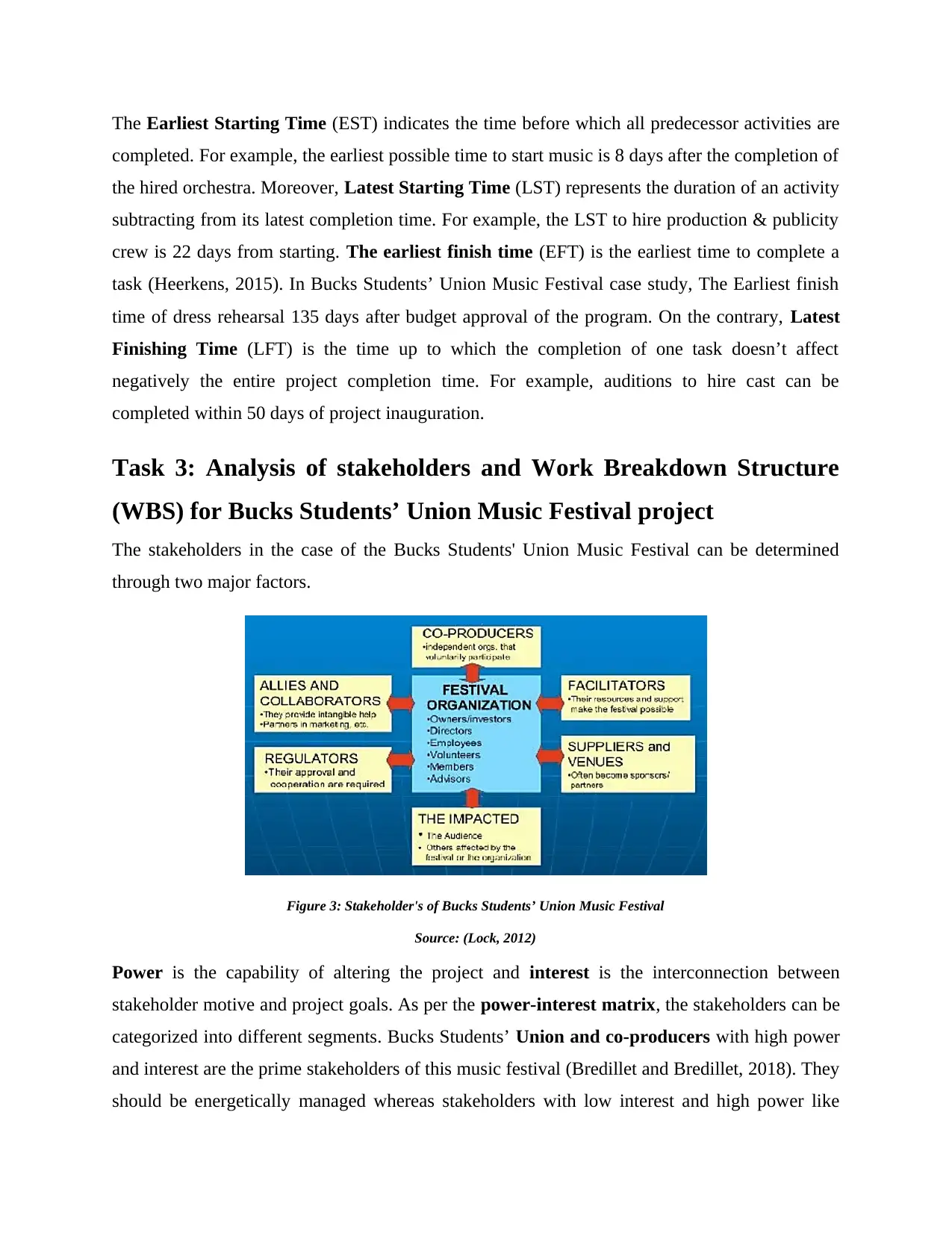
The Earliest Starting Time (EST) indicates the time before which all predecessor activities are
completed. For example, the earliest possible time to start music is 8 days after the completion of
the hired orchestra. Moreover, Latest Starting Time (LST) represents the duration of an activity
subtracting from its latest completion time. For example, the LST to hire production & publicity
crew is 22 days from starting. The earliest finish time (EFT) is the earliest time to complete a
task (Heerkens, 2015). In Bucks Students’ Union Music Festival case study, The Earliest finish
time of dress rehearsal 135 days after budget approval of the program. On the contrary, Latest
Finishing Time (LFT) is the time up to which the completion of one task doesn’t affect
negatively the entire project completion time. For example, auditions to hire cast can be
completed within 50 days of project inauguration.
Task 3: Analysis of stakeholders and Work Breakdown Structure
(WBS) for Bucks Students’ Union Music Festival project
The stakeholders in the case of the Bucks Students' Union Music Festival can be determined
through two major factors.
Figure 3: Stakeholder's of Bucks Students’ Union Music Festival
Source: (Lock, 2012)
Power is the capability of altering the project and interest is the interconnection between
stakeholder motive and project goals. As per the power-interest matrix, the stakeholders can be
categorized into different segments. Bucks Students’ Union and co-producers with high power
and interest are the prime stakeholders of this music festival (Bredillet and Bredillet, 2018). They
should be energetically managed whereas stakeholders with low interest and high power like
completed. For example, the earliest possible time to start music is 8 days after the completion of
the hired orchestra. Moreover, Latest Starting Time (LST) represents the duration of an activity
subtracting from its latest completion time. For example, the LST to hire production & publicity
crew is 22 days from starting. The earliest finish time (EFT) is the earliest time to complete a
task (Heerkens, 2015). In Bucks Students’ Union Music Festival case study, The Earliest finish
time of dress rehearsal 135 days after budget approval of the program. On the contrary, Latest
Finishing Time (LFT) is the time up to which the completion of one task doesn’t affect
negatively the entire project completion time. For example, auditions to hire cast can be
completed within 50 days of project inauguration.
Task 3: Analysis of stakeholders and Work Breakdown Structure
(WBS) for Bucks Students’ Union Music Festival project
The stakeholders in the case of the Bucks Students' Union Music Festival can be determined
through two major factors.
Figure 3: Stakeholder's of Bucks Students’ Union Music Festival
Source: (Lock, 2012)
Power is the capability of altering the project and interest is the interconnection between
stakeholder motive and project goals. As per the power-interest matrix, the stakeholders can be
categorized into different segments. Bucks Students’ Union and co-producers with high power
and interest are the prime stakeholders of this music festival (Bredillet and Bredillet, 2018). They
should be energetically managed whereas stakeholders with low interest and high power like
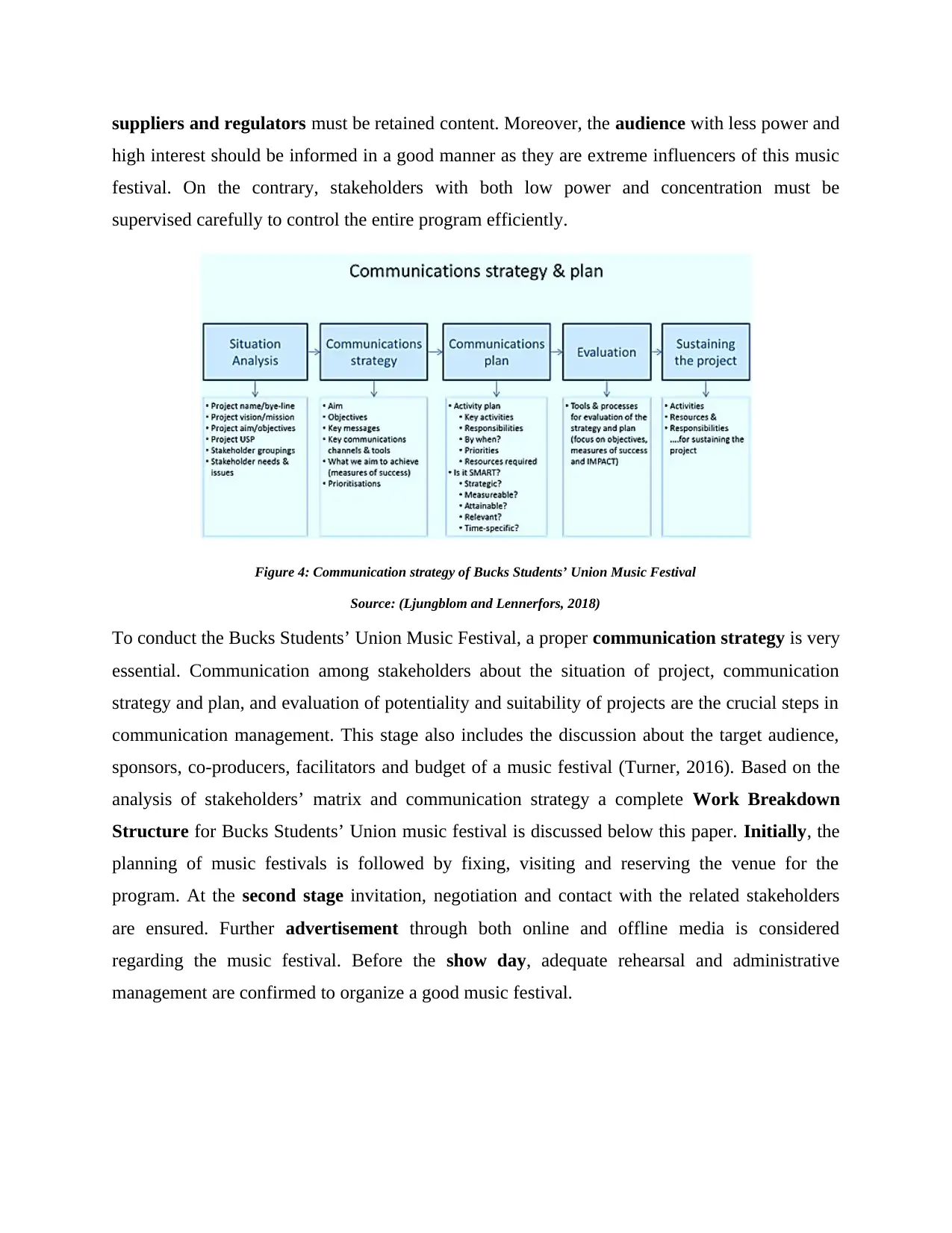
suppliers and regulators must be retained content. Moreover, the audience with less power and
high interest should be informed in a good manner as they are extreme influencers of this music
festival. On the contrary, stakeholders with both low power and concentration must be
supervised carefully to control the entire program efficiently.
Figure 4: Communication strategy of Bucks Students’ Union Music Festival
Source: (Ljungblom and Lennerfors, 2018)
To conduct the Bucks Students’ Union Music Festival, a proper communication strategy is very
essential. Communication among stakeholders about the situation of project, communication
strategy and plan, and evaluation of potentiality and suitability of projects are the crucial steps in
communication management. This stage also includes the discussion about the target audience,
sponsors, co-producers, facilitators and budget of a music festival (Turner, 2016). Based on the
analysis of stakeholders’ matrix and communication strategy a complete Work Breakdown
Structure for Bucks Students’ Union music festival is discussed below this paper. Initially, the
planning of music festivals is followed by fixing, visiting and reserving the venue for the
program. At the second stage invitation, negotiation and contact with the related stakeholders
are ensured. Further advertisement through both online and offline media is considered
regarding the music festival. Before the show day, adequate rehearsal and administrative
management are confirmed to organize a good music festival.
high interest should be informed in a good manner as they are extreme influencers of this music
festival. On the contrary, stakeholders with both low power and concentration must be
supervised carefully to control the entire program efficiently.
Figure 4: Communication strategy of Bucks Students’ Union Music Festival
Source: (Ljungblom and Lennerfors, 2018)
To conduct the Bucks Students’ Union Music Festival, a proper communication strategy is very
essential. Communication among stakeholders about the situation of project, communication
strategy and plan, and evaluation of potentiality and suitability of projects are the crucial steps in
communication management. This stage also includes the discussion about the target audience,
sponsors, co-producers, facilitators and budget of a music festival (Turner, 2016). Based on the
analysis of stakeholders’ matrix and communication strategy a complete Work Breakdown
Structure for Bucks Students’ Union music festival is discussed below this paper. Initially, the
planning of music festivals is followed by fixing, visiting and reserving the venue for the
program. At the second stage invitation, negotiation and contact with the related stakeholders
are ensured. Further advertisement through both online and offline media is considered
regarding the music festival. Before the show day, adequate rehearsal and administrative
management are confirmed to organize a good music festival.
Paraphrase This Document
Need a fresh take? Get an instant paraphrase of this document with our AI Paraphraser
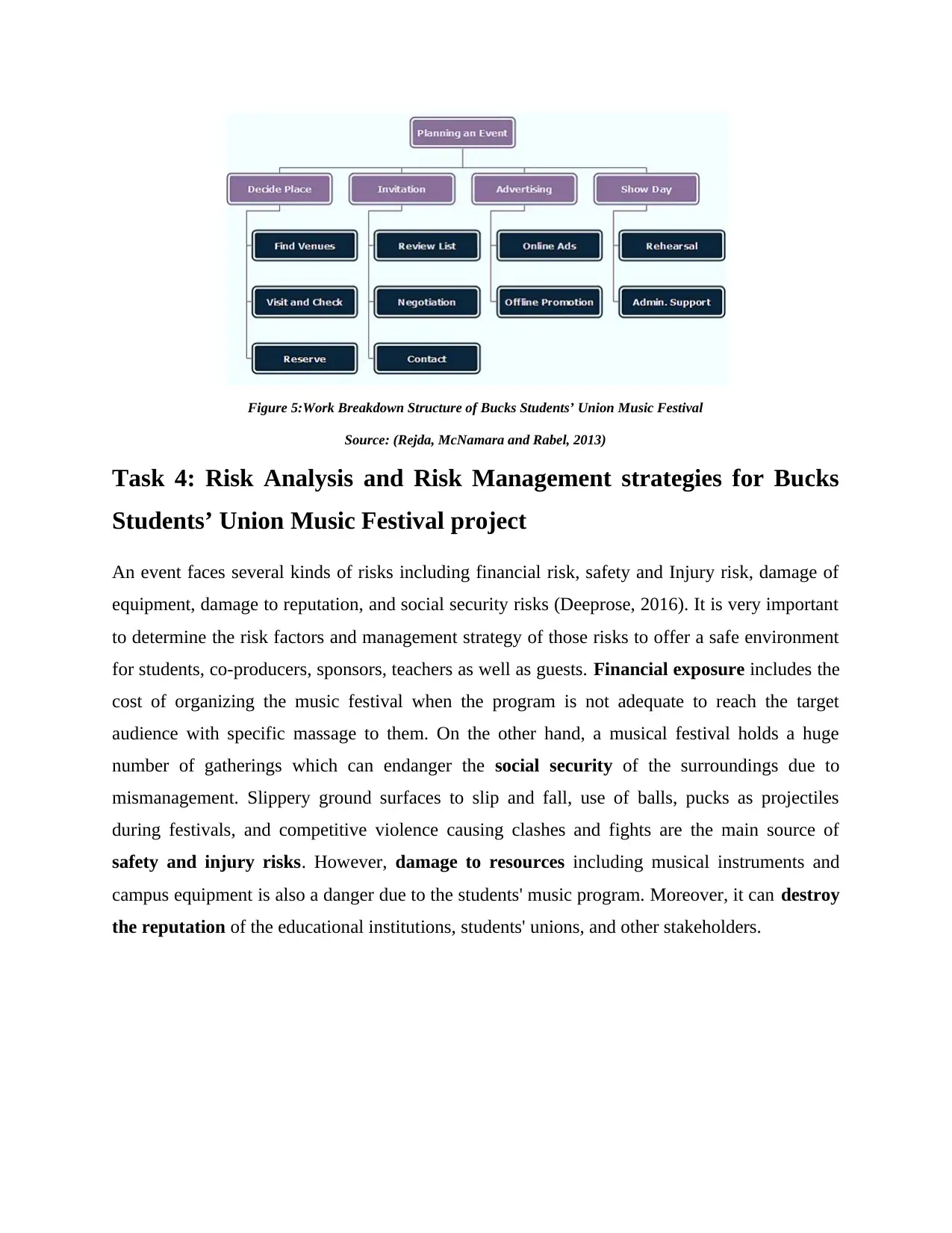
Figure 5:Work Breakdown Structure of Bucks Students’ Union Music Festival
Source: (Rejda, McNamara and Rabel, 2013)
Task 4: Risk Analysis and Risk Management strategies for Bucks
Students’ Union Music Festival project
An event faces several kinds of risks including financial risk, safety and Injury risk, damage of
equipment, damage to reputation, and social security risks (Deeprose, 2016). It is very important
to determine the risk factors and management strategy of those risks to offer a safe environment
for students, co-producers, sponsors, teachers as well as guests. Financial exposure includes the
cost of organizing the music festival when the program is not adequate to reach the target
audience with specific massage to them. On the other hand, a musical festival holds a huge
number of gatherings which can endanger the social security of the surroundings due to
mismanagement. Slippery ground surfaces to slip and fall, use of balls, pucks as projectiles
during festivals, and competitive violence causing clashes and fights are the main source of
safety and injury risks. However, damage to resources including musical instruments and
campus equipment is also a danger due to the students' music program. Moreover, it can destroy
the reputation of the educational institutions, students' unions, and other stakeholders.
Source: (Rejda, McNamara and Rabel, 2013)
Task 4: Risk Analysis and Risk Management strategies for Bucks
Students’ Union Music Festival project
An event faces several kinds of risks including financial risk, safety and Injury risk, damage of
equipment, damage to reputation, and social security risks (Deeprose, 2016). It is very important
to determine the risk factors and management strategy of those risks to offer a safe environment
for students, co-producers, sponsors, teachers as well as guests. Financial exposure includes the
cost of organizing the music festival when the program is not adequate to reach the target
audience with specific massage to them. On the other hand, a musical festival holds a huge
number of gatherings which can endanger the social security of the surroundings due to
mismanagement. Slippery ground surfaces to slip and fall, use of balls, pucks as projectiles
during festivals, and competitive violence causing clashes and fights are the main source of
safety and injury risks. However, damage to resources including musical instruments and
campus equipment is also a danger due to the students' music program. Moreover, it can destroy
the reputation of the educational institutions, students' unions, and other stakeholders.
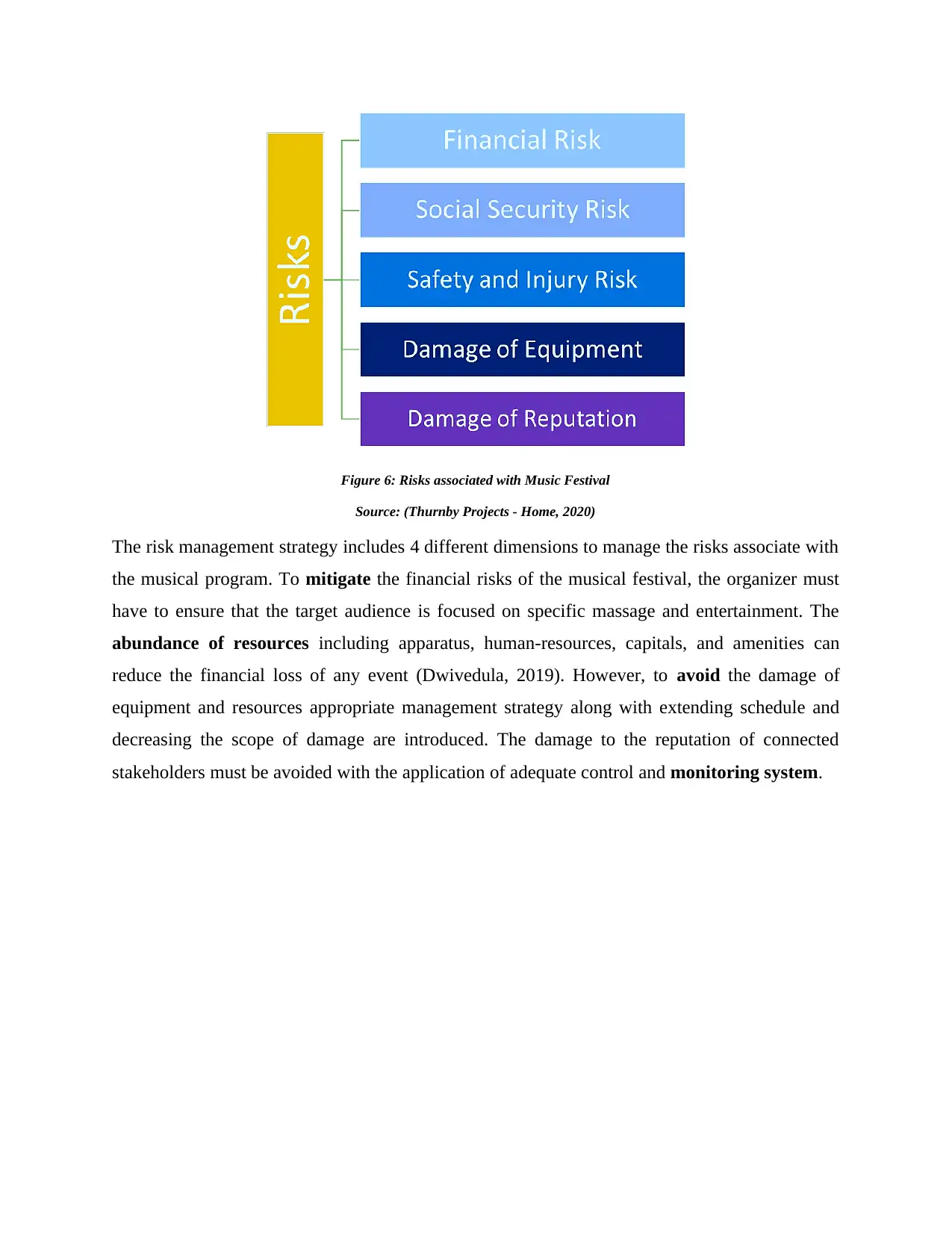
Figure 6: Risks associated with Music Festival
Source: (Thurnby Projects - Home, 2020)
The risk management strategy includes 4 different dimensions to manage the risks associate with
the musical program. To mitigate the financial risks of the musical festival, the organizer must
have to ensure that the target audience is focused on specific massage and entertainment. The
abundance of resources including apparatus, human-resources, capitals, and amenities can
reduce the financial loss of any event (Dwivedula, 2019). However, to avoid the damage of
equipment and resources appropriate management strategy along with extending schedule and
decreasing the scope of damage are introduced. The damage to the reputation of connected
stakeholders must be avoided with the application of adequate control and monitoring system.
Source: (Thurnby Projects - Home, 2020)
The risk management strategy includes 4 different dimensions to manage the risks associate with
the musical program. To mitigate the financial risks of the musical festival, the organizer must
have to ensure that the target audience is focused on specific massage and entertainment. The
abundance of resources including apparatus, human-resources, capitals, and amenities can
reduce the financial loss of any event (Dwivedula, 2019). However, to avoid the damage of
equipment and resources appropriate management strategy along with extending schedule and
decreasing the scope of damage are introduced. The damage to the reputation of connected
stakeholders must be avoided with the application of adequate control and monitoring system.
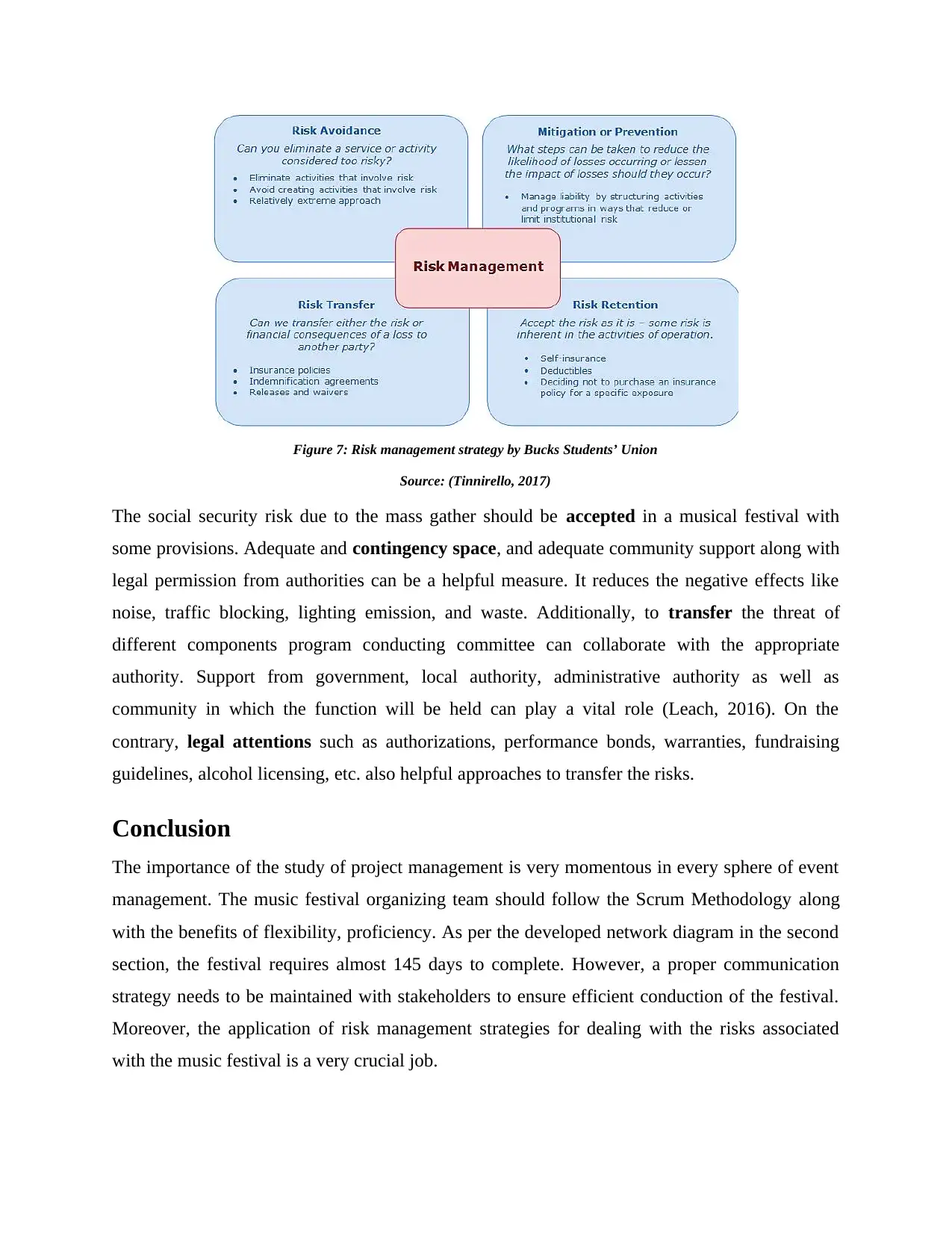
Figure 7: Risk management strategy by Bucks Students’ Union
Source: (Tinnirello, 2017)
The social security risk due to the mass gather should be accepted in a musical festival with
some provisions. Adequate and contingency space, and adequate community support along with
legal permission from authorities can be a helpful measure. It reduces the negative effects like
noise, traffic blocking, lighting emission, and waste. Additionally, to transfer the threat of
different components program conducting committee can collaborate with the appropriate
authority. Support from government, local authority, administrative authority as well as
community in which the function will be held can play a vital role (Leach, 2016). On the
contrary, legal attentions such as authorizations, performance bonds, warranties, fundraising
guidelines, alcohol licensing, etc. also helpful approaches to transfer the risks.
Conclusion
The importance of the study of project management is very momentous in every sphere of event
management. The music festival organizing team should follow the Scrum Methodology along
with the benefits of flexibility, proficiency. As per the developed network diagram in the second
section, the festival requires almost 145 days to complete. However, a proper communication
strategy needs to be maintained with stakeholders to ensure efficient conduction of the festival.
Moreover, the application of risk management strategies for dealing with the risks associated
with the music festival is a very crucial job.
Source: (Tinnirello, 2017)
The social security risk due to the mass gather should be accepted in a musical festival with
some provisions. Adequate and contingency space, and adequate community support along with
legal permission from authorities can be a helpful measure. It reduces the negative effects like
noise, traffic blocking, lighting emission, and waste. Additionally, to transfer the threat of
different components program conducting committee can collaborate with the appropriate
authority. Support from government, local authority, administrative authority as well as
community in which the function will be held can play a vital role (Leach, 2016). On the
contrary, legal attentions such as authorizations, performance bonds, warranties, fundraising
guidelines, alcohol licensing, etc. also helpful approaches to transfer the risks.
Conclusion
The importance of the study of project management is very momentous in every sphere of event
management. The music festival organizing team should follow the Scrum Methodology along
with the benefits of flexibility, proficiency. As per the developed network diagram in the second
section, the festival requires almost 145 days to complete. However, a proper communication
strategy needs to be maintained with stakeholders to ensure efficient conduction of the festival.
Moreover, the application of risk management strategies for dealing with the risks associated
with the music festival is a very crucial job.
Secure Best Marks with AI Grader
Need help grading? Try our AI Grader for instant feedback on your assignments.
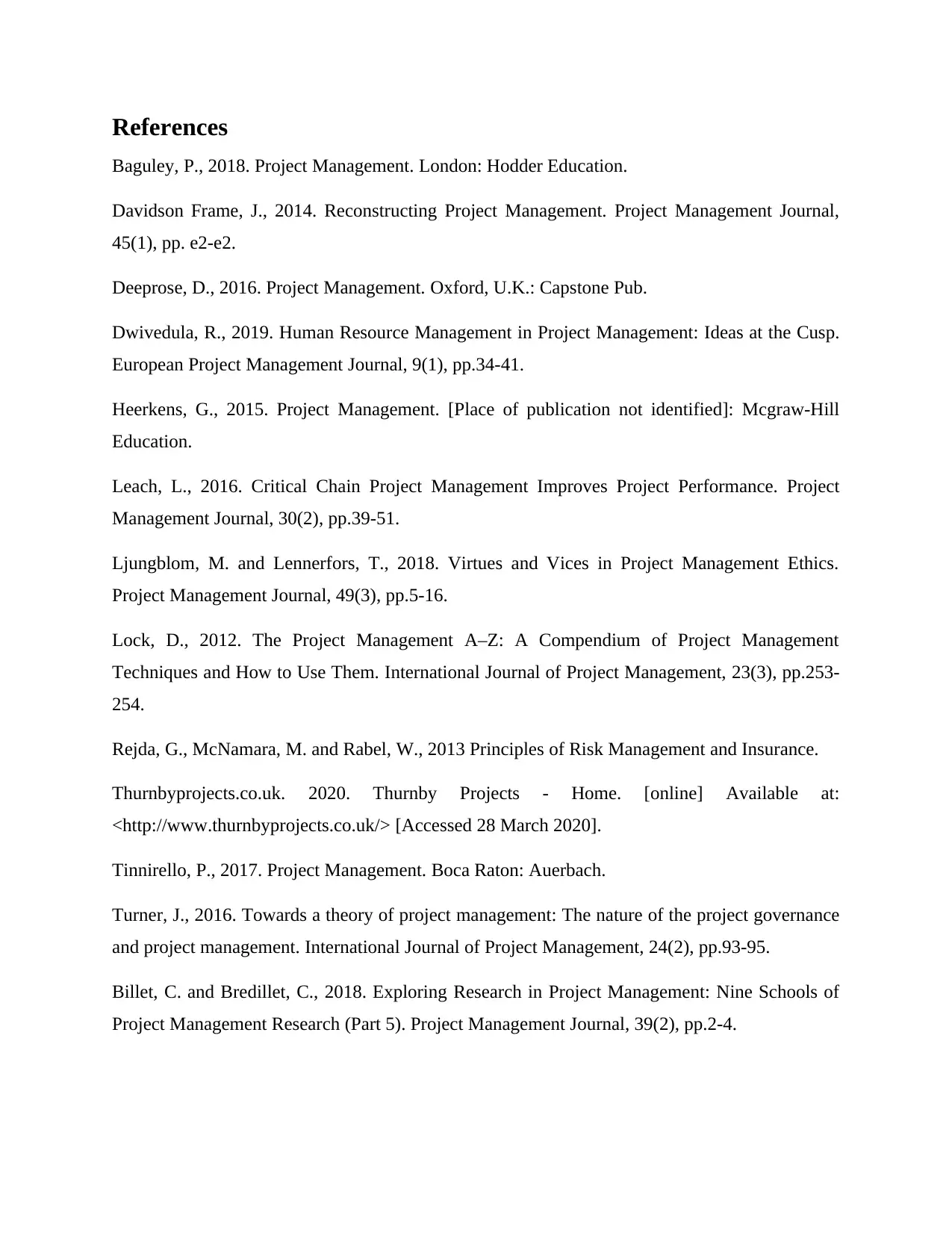
References
Baguley, P., 2018. Project Management. London: Hodder Education.
Davidson Frame, J., 2014. Reconstructing Project Management. Project Management Journal,
45(1), pp. e2-e2.
Deeprose, D., 2016. Project Management. Oxford, U.K.: Capstone Pub.
Dwivedula, R., 2019. Human Resource Management in Project Management: Ideas at the Cusp.
European Project Management Journal, 9(1), pp.34-41.
Heerkens, G., 2015. Project Management. [Place of publication not identified]: Mcgraw-Hill
Education.
Leach, L., 2016. Critical Chain Project Management Improves Project Performance. Project
Management Journal, 30(2), pp.39-51.
Ljungblom, M. and Lennerfors, T., 2018. Virtues and Vices in Project Management Ethics.
Project Management Journal, 49(3), pp.5-16.
Lock, D., 2012. The Project Management A–Z: A Compendium of Project Management
Techniques and How to Use Them. International Journal of Project Management, 23(3), pp.253-
254.
Rejda, G., McNamara, M. and Rabel, W., 2013 Principles of Risk Management and Insurance.
Thurnbyprojects.co.uk. 2020. Thurnby Projects - Home. [online] Available at:
<http://www.thurnbyprojects.co.uk/> [Accessed 28 March 2020].
Tinnirello, P., 2017. Project Management. Boca Raton: Auerbach.
Turner, J., 2016. Towards a theory of project management: The nature of the project governance
and project management. International Journal of Project Management, 24(2), pp.93-95.
Billet, C. and Bredillet, C., 2018. Exploring Research in Project Management: Nine Schools of
Project Management Research (Part 5). Project Management Journal, 39(2), pp.2-4.
Baguley, P., 2018. Project Management. London: Hodder Education.
Davidson Frame, J., 2014. Reconstructing Project Management. Project Management Journal,
45(1), pp. e2-e2.
Deeprose, D., 2016. Project Management. Oxford, U.K.: Capstone Pub.
Dwivedula, R., 2019. Human Resource Management in Project Management: Ideas at the Cusp.
European Project Management Journal, 9(1), pp.34-41.
Heerkens, G., 2015. Project Management. [Place of publication not identified]: Mcgraw-Hill
Education.
Leach, L., 2016. Critical Chain Project Management Improves Project Performance. Project
Management Journal, 30(2), pp.39-51.
Ljungblom, M. and Lennerfors, T., 2018. Virtues and Vices in Project Management Ethics.
Project Management Journal, 49(3), pp.5-16.
Lock, D., 2012. The Project Management A–Z: A Compendium of Project Management
Techniques and How to Use Them. International Journal of Project Management, 23(3), pp.253-
254.
Rejda, G., McNamara, M. and Rabel, W., 2013 Principles of Risk Management and Insurance.
Thurnbyprojects.co.uk. 2020. Thurnby Projects - Home. [online] Available at:
<http://www.thurnbyprojects.co.uk/> [Accessed 28 March 2020].
Tinnirello, P., 2017. Project Management. Boca Raton: Auerbach.
Turner, J., 2016. Towards a theory of project management: The nature of the project governance
and project management. International Journal of Project Management, 24(2), pp.93-95.
Billet, C. and Bredillet, C., 2018. Exploring Research in Project Management: Nine Schools of
Project Management Research (Part 5). Project Management Journal, 39(2), pp.2-4.
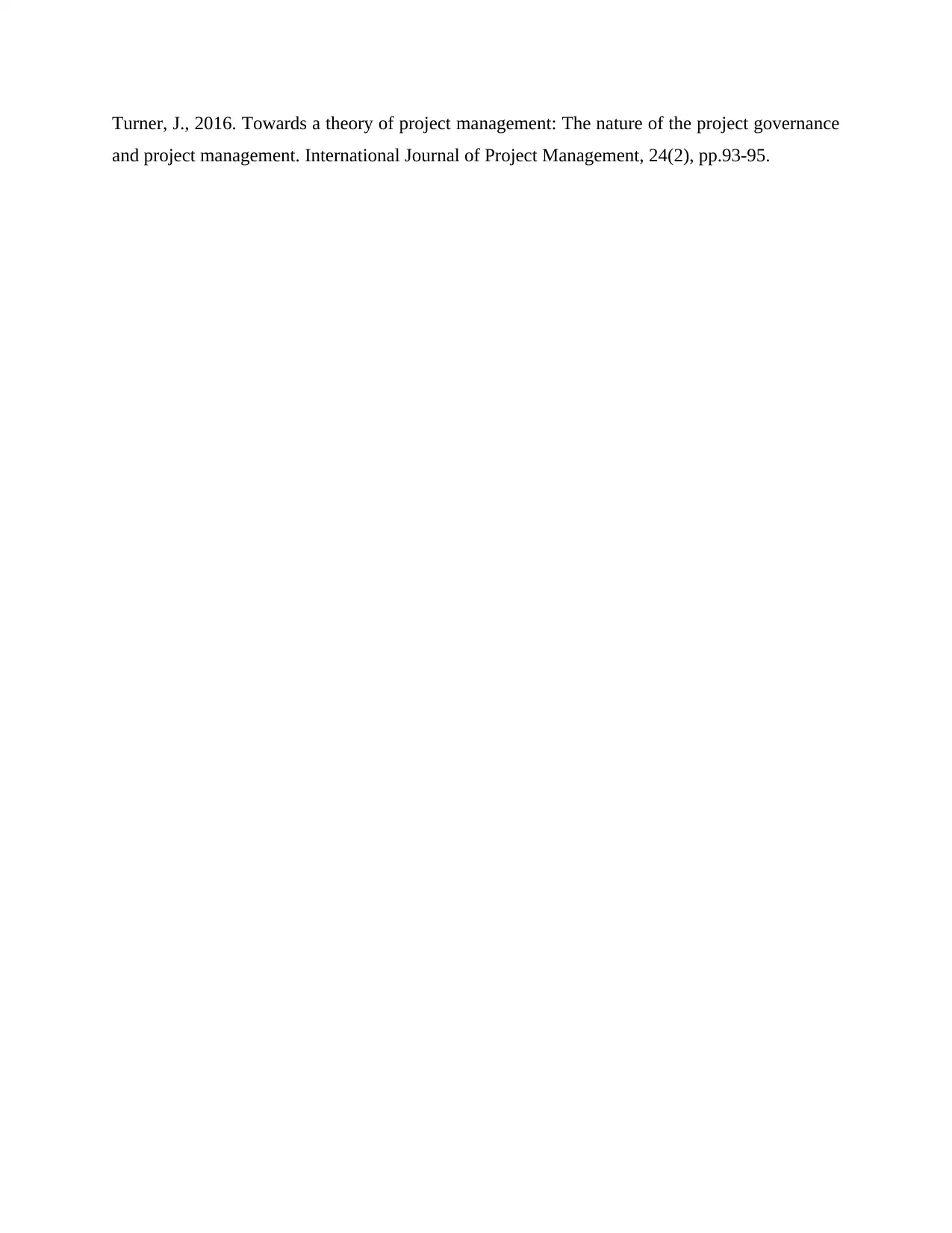
Turner, J., 2016. Towards a theory of project management: The nature of the project governance
and project management. International Journal of Project Management, 24(2), pp.93-95.
and project management. International Journal of Project Management, 24(2), pp.93-95.
1 out of 12
Related Documents
Your All-in-One AI-Powered Toolkit for Academic Success.
+13062052269
info@desklib.com
Available 24*7 on WhatsApp / Email
![[object Object]](/_next/static/media/star-bottom.7253800d.svg)
Unlock your academic potential
© 2024 | Zucol Services PVT LTD | All rights reserved.




